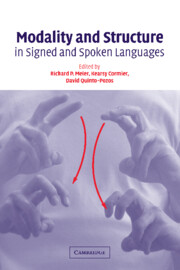Book contents
- Frontmatter
- Contents
- List of figures
- List of tables
- List of contributors
- Acknowledgements
- 1 Why different, why the same? Explaining effects and non-effects of modality upon linguistic structure in sign and speech
- Part I Phonological structure in signed languages
- Part II Gesture and iconicity in sign and speech
- Part III Syntax in sign: Few or no effects of modality
- 10 Where are all the modality effects?
- 11 Applying morphosyntactic and phonological readjustment rules in natural language negation
- 12 Nominal expressions in Hong Kong Sign Language: Does modality make a difference?
- Part IV Using space and describing space: Pronouns, classifiers, and verb agreement
- Index
- References
12 - Nominal expressions in Hong Kong Sign Language: Does modality make a difference?
Published online by Cambridge University Press: 22 September 2009
- Frontmatter
- Contents
- List of figures
- List of tables
- List of contributors
- Acknowledgements
- 1 Why different, why the same? Explaining effects and non-effects of modality upon linguistic structure in sign and speech
- Part I Phonological structure in signed languages
- Part II Gesture and iconicity in sign and speech
- Part III Syntax in sign: Few or no effects of modality
- 10 Where are all the modality effects?
- 11 Applying morphosyntactic and phonological readjustment rules in natural language negation
- 12 Nominal expressions in Hong Kong Sign Language: Does modality make a difference?
- Part IV Using space and describing space: Pronouns, classifiers, and verb agreement
- Index
- References
Summary
Introduction
Signed language research in recent decades has revealed that signed and spoken languages share many properties of natural language, such as duality of patterning and linguistic arbitrariness. However, the fact that there are fundamental differences between the oral–aural and visual–gestural modes of communication leads to the question of the effect of modality on linguistic structure. Various researchers have argued that, despite some superficial differences, signed languages also display the property of formal structuring at various levels of grammar and a similar language acquisition timetable, suggesting that the principles and parameters of Universal Grammar (UG) apply across modalities (Brentari 1998; Crain and Lillo-Martin 1999; Lillo-Martin 1999). The fact that signed and spoken languages share the same kind of cognitive systems and reflect the same kind of mental operations was suggested by Fromkin (1973), who also argued that having these similarities does not mean that the differences resulting from their different modalities are uninteresting. Meier (this volume) compares the intrinsic characteristics of the two modalities and suggests some plausible linguistic outcomes. He also comments that the opportunity to study other signed languages in addition to American Sign Language (ASL) offers a more solid basis to examine this issue more systematically.
This chapter suggests that a potential source of modality effect may lie in the use of space in the linguistic and discourse organization of nominal expressions in signed language.
Information
- Type
- Chapter
- Information
- Modality and Structure in Signed and Spoken Languages , pp. 296 - 320Publisher: Cambridge University PressPrint publication year: 2002
References
Accessibility standard: Unknown
Why this information is here
This section outlines the accessibility features of this content - including support for screen readers, full keyboard navigation and high-contrast display options. This may not be relevant for you.Accessibility Information
- 7
- Cited by
